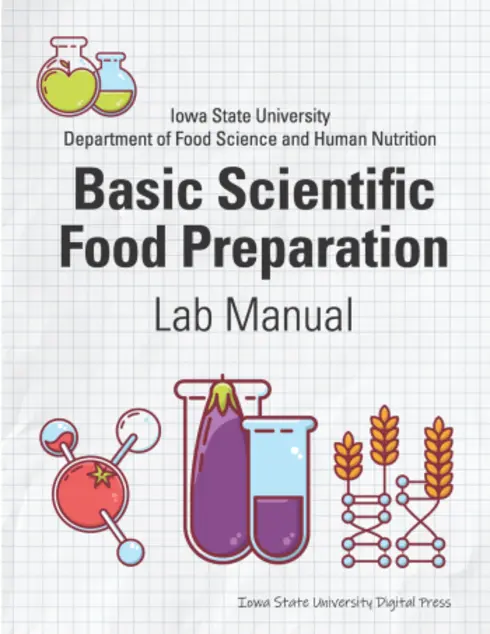
Basic Scientific Food Preparation Lab Manual
![]()
![]()
![]()
![]()
![]()
Iowa State University Department of Food Science and Human Nutrition
Copyright Year:
Publisher: Iowa State University Digital Press
Language: English
Formats Available
Conditions of Use
![]() Attribution-NonCommercial-ShareAlike
Attribution-NonCommercial-ShareAlike
CC BY-NC-SA
Reviews
Reviewed by Karina Christopher, Associate Professor, Berea College on 10/31/24
The book includes all content required for someone teaching a beginner food science or food preparation course. Each section begins with objectives and purpose for the lab. Directions for each lab are clearly written with even spacing and... read more
![]()
![]()
![]()
![]()
![]()
Reviewed by Karina Christopher, Associate Professor, Berea College on 10/31/24
Comprehensiveness
The book includes all content required for someone teaching a beginner food science or food preparation course. Each section begins with objectives and purpose for the lab. Directions for each lab are clearly written with even spacing and appropriate evaluation of understanding. The index and glossary are each to navigate. Students also have the option to search within the text to find key words within context. Within the text, key terms are bolded to draw attention and encourage comprehension.
Content Accuracy
Information is accurate throughout. Ingredients, key terms, recipes, and diagrams all appropriately convey the information based on evidence-based practice.
Relevance/Longevity
Due to the nature of the content, the information is evergreen. Meaning, all information contained within the manual are viable for many years to come. This book could be a staple companion to current and future food science and preparation courses. The content is easy to update and edit as feedback is received by students. The nature of food science means that minimal revisions are needed to content or methodology.
Clarity
The manual uses food science jargon and technical terminology appropriately throughout. The glossary and in-text definitions provide clarity for students. The text overall is concise and without any tone which might inhibit learning.
Consistency
The book is exceptionally consistent. From the first chapter to the last, the format is consistent and clear. Every chapter starts with objectives and laboratory problems followed by instructions and evaluation. The consistency makes it easy for student to navigate.
Modularity
This manual is organized in such a way that instructors could pull out sections throughout and reorganize to fit their own pedagogical style. For example, an instructor could take out content from the Foams chapter and Gluten Development chapter to create a new module related to just cakes. The sections with each chapter are organized in such a way that they could be assigned as subunits.
Organization/Structure/Flow
The organization of this book is unique to previous food science manuals I have reviewed and utilized. However, there is logic behind this manual's organization and it is easily adapted to fit the organizational style of any educator. Because of the consistency in each chapter, modifications to organization on the part of the educator would be seamless.
Interface
Through the review of the PDF and Online text there were no interface or navigation issues. All charts and images were appropriately spaced and organized.
Grammatical Errors
Very well written with no grammatical errors.
Cultural Relevance
The book could benefit from including more variety in the recipes to reflect various cultural foods. The recipes within lean more towards Caucasian American foods rather than other foods within the United States or around the world.
CommentsThis is an excellent introductory food science and preparation book. It would be appropriate for most learning styles and at a variety of reading levels. The organization is clear and concise. With permission, this manual could also be edited or adapted to reflect a specific student population.
Table of Contents
- Introduction
- 1 Laboratory Equipment and Procedures
- 2 Fruits and Vegetables
- 3 Food Preservation
- 4 Beverages
- 5 Crystallization
- 6 Starch Characteristics and Cookery
- 7 Deep Fat Frying
- 8 Dairy Foods
- 9 Eggs
- 10 Foams
- 11 Meats
- 12 Gluten Development
- 13 Steam Leavening
- Appendices
About the Book
This lab book is intended for use in both the lab and kitchen. Each section of the book contains learning objectives, lab problems to be solved, recipes, questions, and observation charts for the input of data.
About the Contributors
Author
Iowa State University Department of Food Science and Human Nutrition
